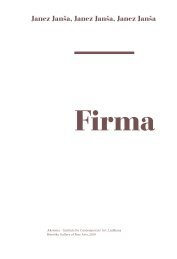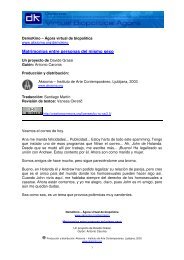You also want an ePaper? Increase the reach of your titles
YUMPU automatically turns print PDFs into web optimized ePapers that Google loves.
30 kulturne scene osemdesetih let. Projekt Janez Janša funkcionirain the service of other authors – two Janez Janšas and Žiga 31kot mreža pomenov. Kot v slikarski realizaciji jeKariž, a former Janez Janša, who is now Janez Janša onlytudi celotni projekt raziskava, ki ni premočrtna in ne težiwhen he uses his pseudonym. These authors have securedk instrumentaliziranemu cilju (npr. družbeni kritiki),their authorship of this project with their signatures on allampak v času ter z nestabilnostmi in spremembami projektanine triptychs. The tension that is thus created raises theustvarja vizualne, performativne in konceptualnequestion of authorship, which in fine arts, despite Warhol,napetosti, ki jih ne podreja uniformni ideološki izjavi.is still understood in emphatically individual terms and itRazmerje med političnim in umetnostjo je le enais considered an expression of work by the artist genius’sod možnosti razbiranja projekta Janez Janša. Političnaown hands. Who, then, is the author – the artist who createdusmeritev umetnikov seveda ni skupinska, ampak gre zathe work or the artists who signed it? And who areindividualne politične usmeritve umetnikov Janeza Janše,the signatories and how many of them are there? Is EmilJaneza Janše in Žige Kariža. Ne izraža se kot podoba političnegaHrvatin a different author from the same person with thev umetniškem projektu, ampak se realizira v celotiname Janez Janša? What is the market and cultural valuenjihovih opusov in javnega delovanja. Projekt sedemindvajsetihof this triptych in comparison to that one? Are they theslik oziroma devetih triptihov ni podoba poli-same or are they different from one another?tičnega v sliki, ampak raziskava možne mreže pomenovThe tension created between the signatures-images andpolitike v slikarstvu.the signatures-signatures raises the question of authorshipKaj je tisto, kar sliko postavi v polje političnega?and copyright. The question is, of course, broader withinGotovo je eden izmed najpomembnejših elementov slikarstva,the context of the broader Janez Janša project. The latterki sliko postavi v okvire „usmerjanja človekoveis so complex that some writers trivialise it into the “mon-dejavnosti v določeni smeri, tj. za uresničevanje določenegastrous three-headed project Janša” and attempt to read itcilja“ 11 , podpis avtorja. Pri slikarskem projektuon a simple, linear level. 9 Yet, the project clearly shows thatJanez Janša sta, kot smo že omenili, nivoja podpisov 11 Igor Lukšič, „Politika“,9 Marina Gržinić, “From it does not come into being through a socially critical statement,Enciklopedija Slo-Biopolitics to Necropoli-nor is it a continuation of excessive identification,dva. Podoba podpisa ni politična, ampak je kakor vsakavenije XV, Mladinskatics and the Institutionpodoba le podoba političnega. Podoba v sliki je tako tudi knjiga, Ljubljana 1995.of Contemporary Art”, which was common among a certain part of the alternativeBiopolitics, Necropoliticszgolj podoba realnega, in ne realno samo. Lastnoročniand de-coloniality, No. 14,and subcultural scene in Ljubljana in the 1980s. The Janezavtorjev podpis – signatura slike – pa je tisti, ki v slikoPavillion, Bucharest 2010, Janša project functions as a network of meanings. Like inpp. 35–48; and Marinavstopa neposredno iz realnega in ni zgolj podoba. SignaturaGržinić, “On the dark a painterly execution, the whole project is an investigation,je družbeno dogovorjeni znak, ki sliko ovrednoti žeside of the Alps”, Maska, which is not straight and it does not strive for an instru-Ljubljana, Nos 113–114,v sliki sami, jo zaznamuje, pripiše in poskrbi, da pridobiSpring 2008, pp. 66–72. mental goal (e.g., social critique); rather, within time andmožnost za svoje kulturno in družbeno ovrednotenje, šewith the instabilities and the changes of the project, it createspreden iz ateljeja vstopi v družbeno. Zato je avtorjev podpisvisual, performative and conceptual tensions, whichslike bolj političen od tistega, kar je na sliki naslikano,are not subject to a uniform ideological statement.saj je slednje le motiv, kakor je motiv podoba stavkajočegaThe relationship between the political and art is onlydelavca, ki ni sama po sebi nič bolj politična od podobeone of the possible ways of reading the Janez Janša project.osamljenega meniha na obali. Če se je projekt JanezOf course, the political orientation of the artists is not collective;Janša prej srečeval z vprašanji slovenskega in mednarod-rather, there are individual political affinities of the10 See, for instance, BlažLukan, “The Janez Janšaproject”, NAME Readymade,Moderna galerija,Ljubljana, Revolver, Berlin2008, pp. 11- 28; andRok Vevar, “Več kot nasbo, hitreje bomo na cilju!”,Večer, 1 September 2007,p. 12.




